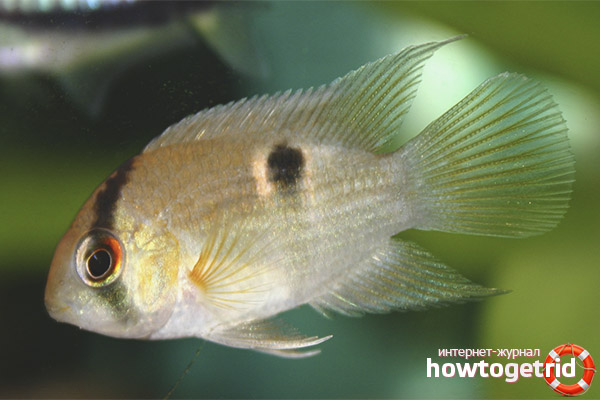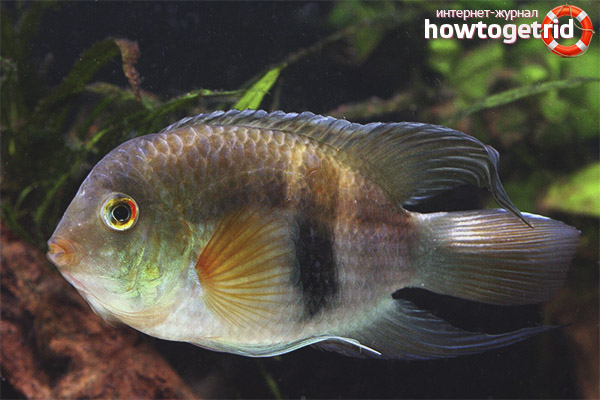The content of the article
Fans of aquarium fish never cease to be surprised when a new species of aquatic inhabitants opens up to their eyes. Today we’ll talk about the Akaroni Maroni - a beautiful, but still not popular fish. Many people who breed fish cannot appreciate the dull color and calmness of the group. But we know how well Maroni get along with other inhabitants of the aquarium, how unpretentious they are in keeping and breeding. However, let's not rush, let's talk about fish in more detail.
Habitat
- Preferably live in Guiana, the region of France and the local rivers. It is also found on the island of Trinidad, but the last time this fish was found there back in 1960. Wild animals are not available for sale, usually fish are bred and farmed, and then sold to breeders.
- For streams and rivers, black water is considered normal, it is in it that by nature they prefer to inhabit fish. Water sources become dark due to the accumulation of tannins and tannins, which are released from the falling leaves. Leaves line the bottom, settle, decompose.
- Water open spaces are famous for their softness, the fish of this species feel comfortable in such conditions. There are few minerals in the rivers, but the acid balance is at the optimum level within 4-5 units.
External data
- The presented individuals are tall, if you look at them from the side. The body is elongated but oblate. Fishes are famous and remembered for large format eyes, as well as a rather large head. The fin on the back is low.
- As for color, individuals are yellowish-gray, brownish, yellow-red. It is interesting that the final shade directly depends on the mood in which the fish is now. There are many spots of brownish-red color on the scales.
- If you look at the representatives of the Maroni family, again, from the side, then in the final part of the fin on the back you can replace a speck of dark shade with a light frame. From this impregnation, a strip of dark tone spreads down.
- In the area of the head, more precisely, in the area of the eyes there is another strip of the same color. As for the shade of the fins, it can be different, ranging from brownish to green-yellow or reddish. The back and dorsal fins always have a white pigmented border.
- Many cannot distinguish a female from a male. The individuals of male gender are larger, they have a bright color. On average, all members of the family can reach a length of about 10 cm.
Conditions of detention
- So we got to the point, namely, the consideration of the intricacies of keeping the fish of this species in aquarium conditions. Since the dimensions are large, to maintain a couple (female + male), a living area of 100 liters is required.
- Fish love to hide and be in silence, so in the aquarium you need to put houses, pots, ceramic pipes and other accessories. All this you can buy in the appropriate store or do it yourself.
- Since the entire Maroni family is classified as shy, the shelters will help fish avoid stressful situations. Akars do not like to frolic in the ground, so it’s enough to equip their water home with special aquarium thickets.
- If there is an opportunity to imitate the habitat preferred for fish, then proceed as follows. At the bottom of the house, line a small sand, you will also need foliage, driftwood, roots and other attributes of this kind. If breeding is planned, it is advisable to put three large smooth pebbles.
- The presented individuals will prefer a refined aquarium with old but clean water to any modern dwelling. It is important that the fluid is enriched with oxygen; purchase appropriate equipment. It is necessary to exclude the accumulation of ammonia substances and nitrates in water.
- The conditions of detention suggest the following: the temperature should be maintained at 22–28 degrees, the optimum level of acid-base balance is considered to be 4–7 units. Watch for the hardness of the water, this data should not go beyond 36-268 ppm.
- Regarding compatibility, fish are classified as cowardly. Therefore, it is necessary to acquire 6-8 individuals at once so that they stray into the pack. Neighbors with aggressive habits are not allowed in the home. Akars do not attack others, but know how to defend themselves when they defend fry. The ideal solution, if you are going to create a large aquarium, plant haracin fish in the acaras.
- You can feed water pets with natural food or purchased dry food. Fish do not show whimsical diet, but it is important to diversify their diet so that the inhabitants look bright and feel good. If you can find food specifically for this species, then go for it.
Breeding
- Buying fry, you will not be able to identify for sure who is who by gender. Usually, breeding starts like this: 6-10 individuals inhabit the aquarium, which subsequently independently break up into pairs.
- Spawning begins without fights and other problems. Akars will gently drive away other guests of the aquarium from their habitat. If the neighbors interfere with the process, the Maroni will stop spawning. Therefore, it is better to either plant outsiders or carefully select neighbors.
- After buying 6-10 individuals, steam is formed in any case. As soon as this happens, it must be transplanted into a separate “nest” with the same conditions as in the main aquarium. Again, enough dwellings of 100 liters. All equipment inside is similar to the above.
There is no difficulty in keeping the presented fish in aquarium conditions. But all inhabitants will need a place for a full existence, so take care of the spacious aquarium and its contents. Remember about water filters, heaters if necessary.
Video: Akara Maroni aquarium fish











Submit